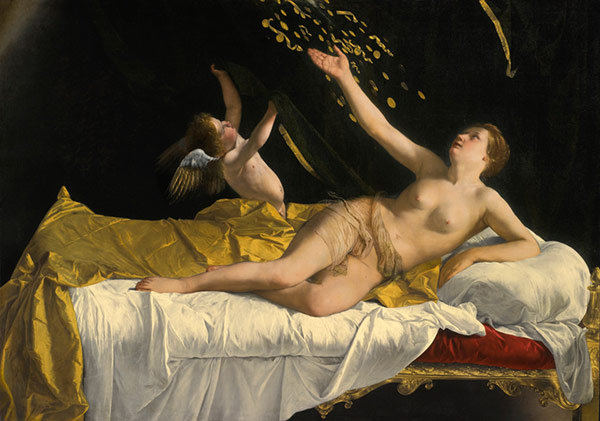In this ongoing series for Fine Art Today, we take a longer look at the history and features of a soon-to-be-available artwork of note. This week: Orazio Gentileschi, “Danaë.”
Orazio Gentileschi’s (1563-1639) “Danaë” is, without a doubt, one of the great masterpieces of Italian Baroque and one of the most significant paintings to head to auction in recent memory. The popular mythological subject, adapted from the recounting in Ovid’s Metamorphoses, was represented by many of the period’s most accomplished painters, including Titian and Rembrandt. The beautiful Danaë is often represented as a reclining nude, locked away in a bronze tower. While her father attempts to keep her from mortal men, the lustful god Jupiter transforms himself into a shower of gold and impregnates her.
Gentileschi’s representation of the scene is nearly flawless and illustrates the painter’s mature period. A Mannerist early in his career, Gentileschi became very much inspired and influenced by the work of Michelangelo Caravaggio (1571-1610), whose dramatic, dark, and multi-figural compositions had taken Rome by storm in 1600. After Caravaggio’s untimely death in 1610, Gentileschi’s Mannerist roots began to resurface through his lighter palette and precision with detail, though the intense spotlighting and black backgrounds popularized by Caravaggio remained.
Gentileschi’s “Danaë” — commissioned in 1621 by the nobleman Giovanni Antonio Sauli for his palazzo in Genoa — “draws together the Caravaggesque naturalism prevalent in early seventeenth-century Italy with the refinement and color which mark the mature style of Gentileschi, one of the most elegant and individual figures of the Italian Baroque,” Sotheby’s notes. Describing the magnificence of the work, Sotheby’s adds, “Gentileschi seamlessly blends the movement and dynamism of the falling gold coins and ribbons with the serenity of Danaë’s sculptural physicality and classical appeal. The diagonal line formed by the curtain which Cupid holds aloft parallels both the coins and Danaë’s arm, accentuating the speed of the gold’s penetration into the scene. Gentileschi’s picture could also be considered one of the highpoints of early seventeenth-century still-life painting since it is a meticulously observed study of light, surface, and color. The various different textures of gold, the sheen of the fabrics, ranging from the gold bedcover to the cool white linen, the deep crimson mattress, the gilt bed and the artichoke-shaped bed knobs are the very highest order.”
As one might expect, a work of this caliber and significance will command a price only a few could possibly afford. Sotheby’s will offer the painting on January 28 at its New York City location during the “Master Paintings Evening Sale.” The auction house expects the painting to realize between $25 million and $30 million.
Accompanying the magnificent painting at Sotheby’s is an engaging film inspired by the piece:
This article was featured in Fine Art Today, a weekly e-newsletter from Fine Art Connoisseur magazine. To start receiving Fine Art Today for free, click here.







